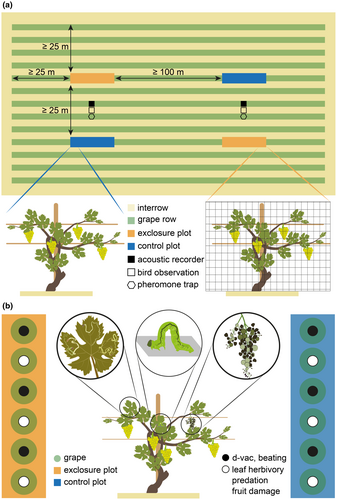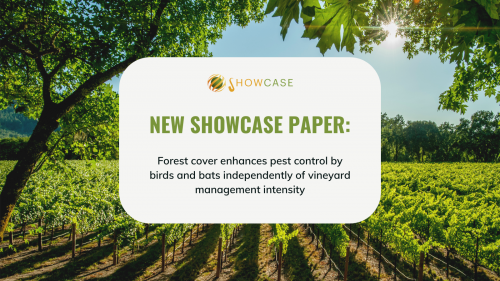As agriculture expands to meet rising demands, biodiversity and ecosystem services often suffer—especially in vineyards, which cover over 7 million hectares globally and still depend heavily on pesticides. Yet, organically managed vineyards in natural habitat-rich landscapes can host diverse communities of pest predators like birds and bats, which provide valuable pest control by consuming large numbers of insect pests, though they may also impact beneficial arthropods.
To better understand these dynamics in European contexts, a SHOWCASE study, authored by partner HUN-REN Centre for Ecological Research in collaboration with University of Milan and Varga Winery, conducted an exclosure experiment in Hungarian vineyards with varying management and landscape features. It aimed to assess how distinct management practices and landscape structure influence bird and bat activity, and whether this, in turn, reduces pest abundance, limits herbivory, enhances yield and potentially affects arthropod predation.
The study took place in 12 Hungarian vineyards varying by management (organic vs. IPM) and landscape (forested vs. non-forested). In each vineyard, paired control and bird/bat exclusion plots (48 total) were established to assess vertebrate impacts on pest control. Birds were surveyed using point counts, bats via acoustic recordings and pest and predatory arthropod data were collected using traps, beating, and D-vac suction sampling, visual inspections and sentinel prey experiments.
Data were analyzed using generalised linear mixed-effects models to test the effects of management and landscape on bird and bat activity, as well as these factors together with vertebrate exclusion on pest abundance, herbivory, fruit damage and yield. Yield loss due to fruit damage was estimated by comparing control and exclusion plots and scaling differences to vineyard production data.
The paper found that more insect-eating birds and bats were active near forests in spring, while bats were more active in open areas during summer. Organic vineyards had more insects, both harmful and helpful, but moth numbers were higher in vineyards using conventional pest control in August. When birds and bats were kept away, there was more leaf eating and fruit damage , which caused a drop in grape yield. In spring, bats helped reduce moth numbers, which in turn lowered fruit damage. Overall, birds and bats play a key role in pest control, especially near deciduous forests that enhance their breeding-season activity. Organic management boosted arthropod abundance and associated predation pressure, while forested landscapes helped lower moth populations and fruit damage.

The results highlight the importance of native forest patches, woody habitats, and organic practices, and suggest that nest boxes and reduced pesticide use can further support vertebrate-driven pest control in vineyards.
Read the full study here.
Image: (a) Spatial arrangement of plots, bat acoustic recorders, bird observation points and pheromone traps within vineyards; (b) grape plants used for arthropod sampling and leaf herbivory, fruit damage and predation measurements within plots.
